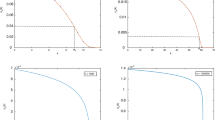Abstract
The Lipschitz constant of a game measures the maximal amount of influence that one player has on the payoff of some other player. The worst-case Lipschitz constant of an n-player k-action \(\delta \)-perturbed game, \(\lambda (n,k,\delta )\), is given an explicit probabilistic description. In the case of \(k\ge 3\), it is identified with the passage probability of a certain symmetric random walk on \({\mathbb {Z}}\). In the case of \(k=2\) and n even, \(\lambda (n,2,\delta )\) is identified with the probability that two i.i.d. binomial random variables are equal. The remaining case, \(k=2\) and n odd, is bounded through the adjacent (even) values of n. Our characterization implies a sharp closed-form asymptotic estimate of \(\lambda (n,k,\delta )\) as \(\delta n /k\rightarrow \infty \).
Similar content being viewed by others
Notes
Restricting the discussion to games with payoffs in [0, 1] does not cause a loss of generality, since the games considered are finite games whose payoffs can be normalized to be in [0, 1] through an affine transformation. The influence of such an affine transformation on the Lipschitz constant of the game is multiplication by the Lipschitz constant of the transformation.
The notion of perturbed strategies in not knew. It appeared in other contexts in game theory, for example, in the definition of Selten’s trembling hand perfect equilibrium (Selten 1975).
A referee noted that \(S^r_n\) is the sum of n i.i.d. random variables that take the value zero with probability \(1-r\) and the values plus and minus one with probability \(\frac{r}{2}\).
An example of a game that attains the asymptotic expression in the case \(k=3\) appears in (Al-Najjar and Smorodinsky 2000, p. 323).
References
Al-Najjar NI, Smorodinsky R et al (2000) Pivotal players and the characterization of in uence. J Econ Theory 92(2):318–342
Azrieli Y, Shmaya E (2013) Lipschitz games. Math Oper Res 38(2):350–357
Cheng Y, Diakonikolas I, Stewart A (2017) Playing anonymous games using simple strategies. pp 616–631
Deb J, Kalai E (2015) Stability in large Bayesian games with heterogeneous players. J Econ Theory 157:1041–1055
Feller W (1968) An introduction to probability theory and its applications, vol 1. Wiley, Amsterdam
Goldberg PW, Turchetta S (2017) Query complexity of approximate equilibria in anonymous games. J Comput Syst Sci 90:80–98
Gradwohl R, Reingold O (2010) Partial exposure in large games. Games Econ Behav 68(2):602–613
Guilherme C, Konrad P (2020) Pure strategy Nash equilibria of large finite-player games and their relationship to non-atomic games. J Econ Theory 187:105015
Kalai E (2004) Large robust games. Econometrica 72(6):1631–1665
Pitman J (1997) Probabilistic bounds on the coefficients of polynomials with only real zeros. J Combin Theory Ser A 77(2):279–303
Platonov ML (1980) Combinatorial numbers of a class of mappings and their applications. Nauka, Moscow
Samuels SM (1965) On the number of successes in independent trials. Ann Math Stat 36(4):1272–1278
Schmeidler D (1973) Equilibrium points of nonatomic games. J Stat Phys 7(4):295–300
Selten R (1975) Reexamination of the perfectness concept for equilibrium points in extensive games. Int J Game Theory 4:25–55
Acknowledgements
We are grateful to MathOverflow for facilitating this collaboration. We thank the members of the Facebook group https://www.facebook.com/groups/305092099620459/ for pointing out references related to the reflection principle. We thank anonymous editor and referee for many corrections and ideas for improvement that helped to shape the final version of the paper. Amnon Schreiber is supported in part by the Israel Science Foundation Grant 2897/20. Ron Peretz is supported in part by the Israel Science Foundation Grant 2566/20.
Author information
Authors and Affiliations
Corresponding author
Additional information
Publisher's Note
Springer Nature remains neutral with regard to jurisdictional claims in published maps and institutional affiliations.
Rights and permissions
About this article
Cite this article
Peretz, R., Schreiber, A. & Schulte-Geers, E. The Lipschitz constant of perturbed anonymous games. Int J Game Theory 51, 293–306 (2022). https://doi.org/10.1007/s00182-021-00793-x
Accepted:
Published:
Issue Date:
DOI: https://doi.org/10.1007/s00182-021-00793-x




